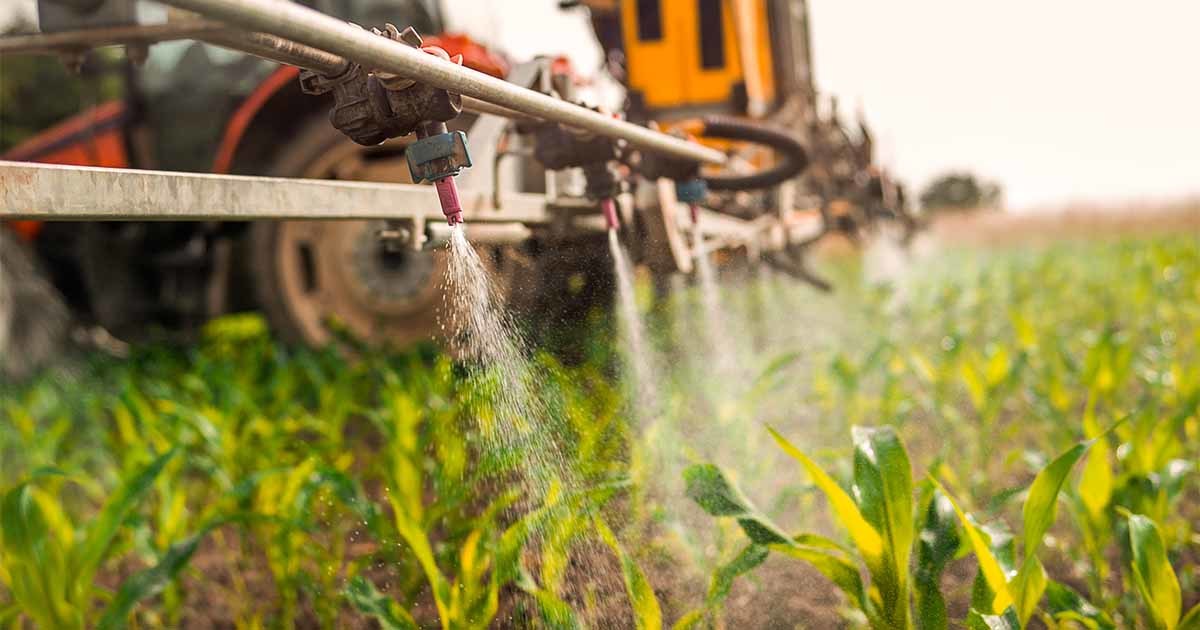Home>Gardening News and Trends>Latest News>What Kind Of Food Contamination Are Pesticides Cleaning Products And Food Allergens Considered?


Latest News
What Kind Of Food Contamination Are Pesticides Cleaning Products And Food Allergens Considered?
Modified: January 22, 2024
Latest News: Discover the types of food contamination, including pesticides, cleaning products, and food allergens, that are being considered in this insightful article.
(Many of the links in this article redirect to a specific reviewed product. Your purchase of these products through affiliate links helps to generate commission for Chicagolandgardening.com, at no extra cost. Learn more)
Table of Contents
Introduction
Welcome to the world of food contamination, where substances like pesticides, cleaning products, and food allergens can pose significant risks to our health. In this article, we will explore the different types of food contamination caused by these substances and their potential impact on our well-being.
Food contamination is a pressing concern in today’s society, as it can lead to various health issues and jeopardize food safety. Pesticides, which are widely used in agricultural practices to control pests and enhance crop production, have been found to contaminate our food supply. Similarly, cleaning products used in food preparation areas can leave behind residues that can find their way into our meals. Lastly, food allergens are substances that trigger an allergic reaction in susceptible individuals and can inadvertently contaminate food during processing or preparation.
Understanding the different types of food contamination can empower us to make informed choices about the food we consume and take measures to minimize our exposure to potentially harmful substances. By delving into the specifics of each type of contamination, we can gain a clearer picture of the risks they pose and the steps we can take to protect ourselves.
Throughout this article, we will examine the various forms of contamination separately, analyzing the types of substances involved and their potential health effects. We will also explore the regulations and guidelines in place to mitigate contamination risks and ensure food safety.
So, let’s dive into the world of food contamination to better understand the impact of pesticides, cleaning products, and food allergens on our food supply and our health.
Pesticide Contamination
Pesticides, a class of chemicals used to control or eliminate pests like insects, weeds, and fungi, can unintentionally contaminate our food. These substances are commonly applied to crops to enhance their growth and protect them from pests that can damage or destroy the yield. However, residues from these pesticides can remain on the produce even after harvesting.
There are various types of pesticides used in agriculture, including insecticides, herbicides, fungicides, and rodenticides. Each type is formulated to target specific pests and poses unique contamination risks to our food supply.
Insecticides are designed to target and kill insects that can harm crops. They can be absorbed by the plants’ tissues or form a coating on the surface of the produce, leading to potential contamination. Herbicides, on the other hand, are used to control weeds, and if not used correctly, they can come into direct contact with edible plants, leading to contamination.
Fungicides, as the name suggests, are used to combat fungal diseases that can harm crops. When applied to crops, they can leave residues that, if not properly managed, can contaminate the food we consume. Lastly, rodenticides are chemicals used to control and eliminate rodents, and if not used responsibly, they can contaminate both the environment and the food chain.
Exposure to pesticide-contaminated food can have adverse health effects. Some pesticides have been linked to chronic health conditions, including cancer, neurological disorders, and hormonal disruptions. The level of risk depends on several factors, such as the type of pesticide, the amount ingested, and the individual’s sensitivity to the chemical.
To mitigate pesticide contamination and protect consumers, regulatory authorities establish maximum residue limits (MRLs) for commonly used pesticides. These limits define the maximum allowable concentration of pesticide residues in food. Regular monitoring and testing are conducted to ensure compliance with these standards and to detect any potential violations.
Consumers can reduce their exposure to pesticide-contaminated food by adopting certain practices. Washing fruits and vegetables thoroughly under running water before consuming them can help remove potential residues. Additionally, purchasing organic produce or locally grown foods from trusted sources can reduce the risk of pesticide contamination.
Having an understanding of pesticide contamination and its potential health effects enables us to make informed choices about the food we consume. By advocating for safe agricultural practices and supporting sustainable farming methods, we can contribute to a safer and healthier food supply.
Types of Pesticides
Pesticides are classified into different categories based on their target pests and application methods. Understanding the various types of pesticides can help us better comprehend their potential impact on our food supply and health.
1. Insecticides: Insecticides are pesticides specifically formulated to control or eliminate insects. They target a wide range of insects, including beetles, flies, mosquitoes, and aphids. Insecticides can be applied to crops through various methods, including spraying, dusting, and soil treatment. Some commonly used insecticides include pyrethroids, organophosphates, and neonicotinoids.
2. Herbicides: Herbicides, as the name suggests, are chemicals used to control and eliminate unwanted weeds. They are mainly used in agricultural and gardening settings to prevent weeds from competing with crops or overshadowing desired plants. Glyphosate, commonly known as Roundup, is a widely used herbicide that has come under scrutiny due to its potential health effects.
3. Fungicides: Fungicides are pesticides used to control fungal diseases that can harm crops and plants. Fungal infections can lead to reduced yields, poor quality produce, and even crop losses. Fungicides are applied to plants and crops to prevent or eliminate these infections. Examples of fungicides include copper-based compounds, azoles, and strobilurins.
4. Rodenticides: Rodenticides are pesticides formulated to control and eliminate rodents, such as rats and mice, that can cause damage to crops and spread diseases. Rodenticides are typically used in agricultural settings, warehouses, and residential areas. However, they can pose risks to non-target animals and potentially contaminate the food chain if not used appropriately.
5. Molluscicides: Molluscicides are used to control snails and slugs, which can cause damage to crops. These pesticides are often used in agricultural settings to protect plants and prevent yield losses. The active ingredients in molluscicides can vary, but metaldehyde and iron phosphate are commonly used substances.
It is essential to note that each type of pesticide has its specific usage instructions and potential risks. Proper application, adherence to safety guidelines, and compliance with regulatory standards are crucial to minimize contamination risks and protect the environment and human health.
Regulatory bodies around the world establish guidelines, regulations, and tolerance limits for the use of pesticides in agriculture. These measures aim to ensure the safe use of pesticides and the protection of consumers and the environment from potential harm.
By staying informed about the various types of pesticides and their potential risks, we can make educated choices when it comes to selecting the food we consume. Opting for organic produce or supporting sustainable farming practices can reduce exposure to pesticide residues, contributing to a healthier and safer food supply.
Health Concerns with Pesticide Contamination
Pesticide contamination in food raises significant health concerns due to the potential risks associated with exposure to these chemical residues. Although the level of risk depends on various factors like the type of pesticide, the amount consumed, and an individual’s sensitivity, it is essential to understand the potential health effects.
1. Acute Health Effects: Short-term exposure to high levels of pesticides can lead to acute health effects. Symptoms may include dizziness, nausea, headaches, vomiting, abdominal pain, respiratory issues, and skin irritation. These symptoms can vary depending on the type of pesticide and the individual’s susceptibility.
2. Chronic Health Effects: Chronic exposure to pesticides over a prolonged period can increase the risk of developing chronic health conditions. Some studies have linked certain pesticides to an increased incidence of cancer, neurological disorders, reproductive issues, endocrine disruptions, and developmental abnormalities. However, further research is needed to fully understand and establish the long-term health effects of pesticide exposure.
3. Environmental Impact: Pesticides not only pose risks to human health but also have adverse effects on the environment. They can contaminate soil, water bodies, and air, leading to ecological imbalances and harming non-target organisms such as beneficial insects, birds, and aquatic life. Proper pesticide management and adopting sustainable agricultural practices can help minimize these environmental impacts.
Regulatory authorities set maximum residue limits (MRLs) for pesticide residues in food. These limits are established based on extensive scientific research and aim to protect consumers from excessive exposure to pesticides. Regular monitoring and enforcement measures are in place to ensure compliance with these safety standards.
To reduce the risk of pesticide contamination and minimize exposure, consumers can adopt several practices:
- Wash produce thoroughly: Cleaning fruits and vegetables under running water can help remove pesticide residues on the surface.
- Peel and trim: Peeling outer layers of fruits and vegetables or removing the outer leaves of leafy greens can further reduce pesticide exposure.
- Choose organic options: Opting for organic produce, which is grown without synthetic pesticides, can lower the risk of contamination.
- Diversify your diet: Consuming a variety of foods can minimize the potential exposure to high levels of specific pesticide residues.
- Support sustainable farming practices: Encouraging and supporting farmers who adopt integrated pest management (IPM) techniques can promote the use of safer alternatives to pesticides.
By being aware of the health concerns associated with pesticide contamination, we can make informed decisions about the food we consume and support practices that prioritize food safety and minimize the use of harmful chemicals.
Cleaning Product Contamination in Food
In addition to pesticide contamination, food can also be at risk of contamination from cleaning products. Cleaning products such as detergents, sanitizers, and disinfectants play a crucial role in maintaining cleanliness and hygiene in food preparation areas. However, if not used correctly or if residues are not properly rinsed off, these products can leave behind chemical residues that may contaminate the food we consume.
The contamination of food with cleaning products can occur through various routes:
- Improper rinsing: Failure to thoroughly rinse surfaces, utensils, and equipment after cleaning them with detergents or disinfectants can result in residual traces transferring onto food.
- Direct contact: In some cases, cleaning products may come into direct contact with food due to mishandling, accidental spills, or improper storage.
- Aerosolized particles: Certain cleaning products can generate aerosols or fine particles that can settle on food surfaces, leading to contamination.
The chemical residues left behind by cleaning products may vary depending on the specific product used. Common ingredients in cleaning products include surfactants, solvents, fragrances, and disinfectants. While these ingredients are generally safe when used as intended, their presence in food can raise concerns over potential health effects.
Exposure to cleaning product residues in food can lead to various health concerns:
- Digestive system irritation: Ingesting food contaminated with cleaning product residues can lead to gastrointestinal irritation, including nausea, vomiting, and stomach pain.
- Chemical toxicity: Some cleaning products contain chemicals that, when ingested in high amounts, can be toxic and may have adverse effects on organ function.
- Allergic reactions: Individuals with sensitivities or allergies to certain cleaning product ingredients may experience allergic reactions when exposed to food contaminated with these residues.
To mitigate the risk of cleaning product contamination in food, it is crucial to follow good cleaning and hygiene practices in food preparation areas:
- Use approved products: Ensure that cleaning products used in food preparation areas are specifically formulated for use in those areas and are approved for contact with food.
- Follow instructions: Adhere to the instructions provided by the manufacturer, including proper dilution ratios and recommended contact times.
- Thorough rinsing: After cleaning surfaces, utensils, and equipment, thoroughly rinse them with potable water to remove any residual cleaning product.
- Store cleaning products properly: Store cleaning products in designated areas away from food storage or preparation areas to minimize the risk of accidental contamination.
- Regular monitoring: Implement regular inspections and audits to ensure proper cleaning procedures are followed and to identify any potential sources of contamination.
By maintaining proper cleaning practices and ensuring the safe use of cleaning products, we can minimize the risk of contamination and help ensure the safety of the food we consume.
Common Food Allergens
Food allergies affect a significant portion of the population, with certain foods triggering immune system responses in susceptible individuals. These foods, known as food allergens, can cause mild to severe allergic reactions, making it crucial to identify and avoid them for individuals with allergies. Here we explore some of the most common food allergens:
- Milk: Milk allergy is the most common food allergy in infants and young children. It is a reaction to proteins found in cow’s milk, which can cause symptoms like hives, vomiting, diarrhea, and in severe cases, anaphylaxis.
- Eggs: Eggs are another common food allergen, particularly in children. The proteins in egg whites and yolks can trigger allergic reactions such as skin rashes, gastrointestinal problems, and respiratory distress.
- Wheat: Wheat allergy is a common food allergy, especially in children. It is triggered by proteins in wheat and can cause symptoms ranging from skin rashes and digestive issues to respiratory problems and anaphylaxis.
- Soy: Soy allergy occurs when the body reacts adversely to proteins found in soybeans. It can cause symptoms like hives, itching, swelling, digestive issues, and in severe cases, anaphylaxis.
- Shellfish: Shellfish allergies are more common in adults and can trigger severe allergic reactions. Allergies to crustaceans (shrimp, crab, lobster) and mollusks (clams, mussels, oysters) can cause symptoms like hives, swelling, difficulty breathing, and anaphylaxis.
- Tree Nuts: Tree nuts, including almonds, walnuts, cashews, and pistachios, are frequent triggers for allergies. Allergic reactions to tree nuts can range from mild symptoms like itchiness and swelling to more severe reactions, including anaphylaxis.
- Peanuts: Peanut allergies are common and can cause severe allergic reactions. Even tiny amounts of peanuts or peanut-derived products can trigger symptoms such as hives, swelling, respiratory distress, and anaphylaxis.
- Fish: Fish allergies typically occur in adulthood and can lead to severe allergic reactions. Allergies to fish like salmon, tuna, and cod can cause symptoms ranging from hives and swelling to difficulty breathing and anaphylaxis.
These are just a few examples of common food allergens; however, other foods can also trigger allergic reactions in susceptible individuals. It is important to note that food allergies can vary in severity, with some individuals experiencing mild symptoms while others are at risk of life-threatening allergic reactions. Therefore, it is crucial for those with food allergies and their caregivers to be vigilant and take appropriate precautions when it comes to food consumption.
If you suspect you have a food allergy, it is essential to seek medical advice for proper diagnosis and management. Allergy testing, including skin prick tests and blood tests, can help identify specific allergens for an accurate diagnosis.
Food labeling regulations require manufacturers to clearly indicate the presence of common food allergens on their product labels. This allows individuals with allergies to identify and avoid foods that may trigger allergic reactions. However, cross-contamination can still occur, making it important for individuals with severe allergies to be cautious when consuming packaged or prepared foods.
By raising awareness about common food allergens and practicing diligent label reading and avoidance, we can help create safer environments and ensure the well-being of individuals with food allergies.
Allergen Contamination in Food
Allergen contamination in food refers to the unintended presence of food allergens in products that are not supposed to contain them. Cross-contamination can occur during various stages of food production, processing, and preparation, putting individuals with food allergies at risk of exposure to allergens. Here, we explore the sources and risks of allergen contamination in food.
Cross-contamination can occur through several routes:
- Shared Equipment: When food products are processed or prepared on shared equipment or production lines that handle allergenic ingredients, there is a risk of cross-contact. For example, if a machine used to produce a product containing peanuts is not properly cleaned before processing another product, there is a possibility of peanut allergen contamination.
- Improper Handling: In restaurants, cafes, and other food establishments, inadequate cleaning of cooking utensils, cutting boards, and food preparation surfaces can lead to cross-contamination. If allergenic foods are not stored properly or if utensils are not appropriately cleaned between uses, allergens can be transferred to non-allergenic foods.
- Mislabeling: Incorrect or incomplete labeling of ingredients in packaged foods can lead to inadvertent consumption of allergens. If an allergenic ingredient is not declared on the label or if it is listed using alternative names or terms that are not easily recognizable, individuals with allergies may unknowingly consume products containing allergens.
The risks associated with allergen contamination in food can vary depending on the sensitivity of individuals and the severity of their allergies. For those with severe allergies, even trace amounts of allergens can trigger severe allergic reactions, including anaphylaxis, which is a potentially life-threatening condition.
Common symptoms of allergic reactions to food allergens include hives, swelling, itching, respiratory difficulties, gastrointestinal issues, and in severe cases, a drop in blood pressure and loss of consciousness. Promptly identifying and treating allergic reactions is essential to prevent severe outcomes.
Food allergen labeling regulations require manufacturers to clearly indicate the presence of common allergenic ingredients on product labels. However, it is important to note that accidental cross-contamination may still occur, even in products that do not contain allergenic ingredients. Manufacturers may include precautionary labels such as “may contain” or “processed in a facility that also handles” to inform consumers about possible allergen contamination risks.
For individuals with food allergies, strict avoidance of allergenic foods is essential. This involves careful label reading, seeking clarification from manufacturers if necessary, and being aware of hidden sources of allergens. Additionally, open communication with food service establishments and asking about allergen handling practices can help individuals make informed choices about dining out.
Food businesses also play a vital role in preventing allergen contamination. Implementing strict allergen management protocols, including proper cleaning procedures, separate storage of allergenic ingredients, and staff training on allergen handling, can significantly reduce the risk of cross-contamination and protect individuals with food allergies.
By understanding the sources and risks of allergen contamination in food, we can take proactive measures to ensure the safety and well-being of individuals with food allergies. It is crucial for individuals with allergies, their caregivers, food establishments, and manufacturers to work together to minimize the risk of allergen contamination and provide safe food options for everyone.
Risks and Health Effects of Allergen Contamination
Allergen contamination in food poses significant risks to individuals with food allergies, as even small traces of allergens can cause allergic reactions. Understanding the health effects and potential risks of allergen contamination is crucial to ensure the safety of those with food allergies.
The health effects of allergen contamination can vary depending on the severity of an individual’s allergic reaction and the amount of allergen consumed. For individuals with severe allergies, even tiny amounts of allergens can trigger a severe allergic reaction known as anaphylaxis. Anaphylaxis is a severe and potentially life-threatening condition characterized by symptoms such as difficulty breathing, swelling, a drop in blood pressure, and loss of consciousness. Prompt medical attention and the administration of epinephrine (adrenaline) through an autoinjector (EpiPen) are crucial in managing anaphylaxis.
Even in cases where the allergic reaction is not life-threatening, allergen contamination can cause a range of unpleasant symptoms, including:
- Hives: Raised, itchy welts on the skin
- Swelling: Swelling of the face, lips, tongue, or throat
- Itching: Persistent itchiness in various parts of the body
- Respiratory issues: Wheezing, coughing, shortness of breath
- Gastrointestinal problems: Abdominal pain, vomiting, diarrhea
Long-term exposure to allergen contamination can also have detrimental effects on an individual’s quality of life. The constant risk of accidental exposure to allergens can lead to increased anxiety and a constant need to be vigilant about the foods consumed. This can result in social limitations, increased stress, and a negative impact on emotional well-being.
To minimize the risks of allergen contamination, individuals with food allergies should take proactive measures:
- Strict avoidance: It is crucial for individuals with food allergies to strictly avoid consuming foods that contain allergens they are sensitive to.
- Reading labels: Careful reading of food labels to identify potential allergens and cross-contamination risks is essential.
- Open communication: Informing food service establishments about specific food allergies and asking about their allergen handling practices can help ensure safe dining experiences.
- Education and awareness: Staying informed about new products and potential sources of allergen contamination can help individuals make informed choices about the foods they consume.
Food manufacturers and food service establishments play a vital role in preventing allergen contamination. Implementing strict allergen management protocols, including proper cleaning procedures, separate preparation areas for allergen-free foods, and staff training on allergen handling, can help reduce the risk of allergen cross-contamination.
By understanding the risks and health effects of allergen contamination, we can work together to create safer environments and ensure the well-being of individuals with food allergies.
Conclusion
Food contamination poses significant risks to our health, and it is essential to understand the various types and sources of contamination. Pesticide contamination can occur through the use of pesticides in agriculture, highlighting the importance of washing produce and supporting organic and sustainable farming practices. Cleaning product contamination in food can result from improper handling and inadequate rinsing, emphasizing the need for proper cleaning procedures and storage. Allergen contamination, on the other hand, can lead to severe allergic reactions, highlighting the importance of strict avoidance and open communication with food establishments.
By raising awareness about these forms of contamination, we can make informed choices about the food we consume and take necessary precautions to mitigate the risks. Thoroughly washing produce, reading food labels carefully, and asking about allergen handling practices can help minimize exposure to pesticides and allergens. Supporting sustainable farming methods and advocating for responsible cleaning procedures can contribute to a safer and healthier food supply.
It is crucial for individuals with food allergies to be diligent in avoiding allergenic foods and understanding the potential risks of cross-contamination. Open communication with food service establishments, labeling regulations, and strict adherence to safe handling practices can help protect individuals with allergies from exposure to allergens. Additionally, education and awareness about food allergies and proper cleaning practices can help reduce the risks associated with cleaning product contamination.
Overall, by being knowledgeable about food contamination and taking proactive measures to reduce exposure, we can strive towards a safer and healthier food environment. Through collaboration between consumers, manufacturers, and food establishments, we can ensure the well-being of individuals with food allergies, promote food safety, and make informed choices about the food we consume.







